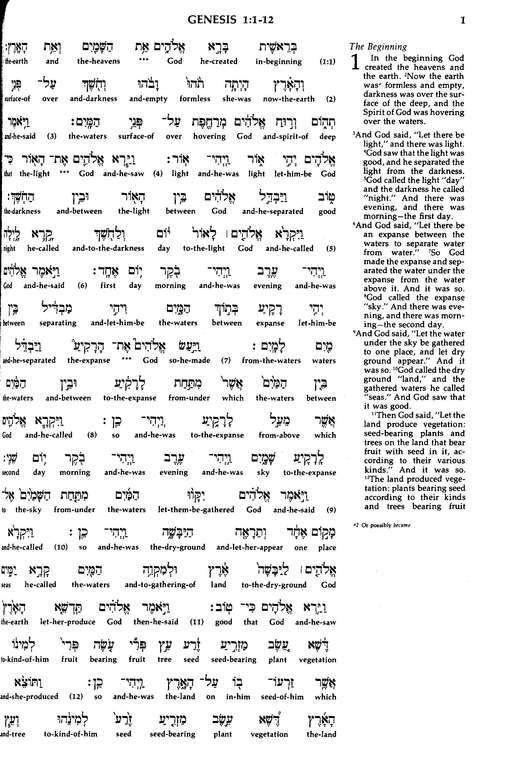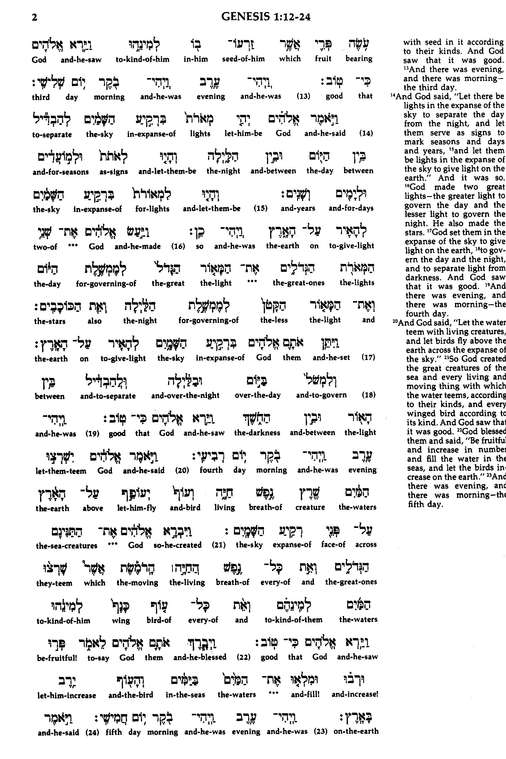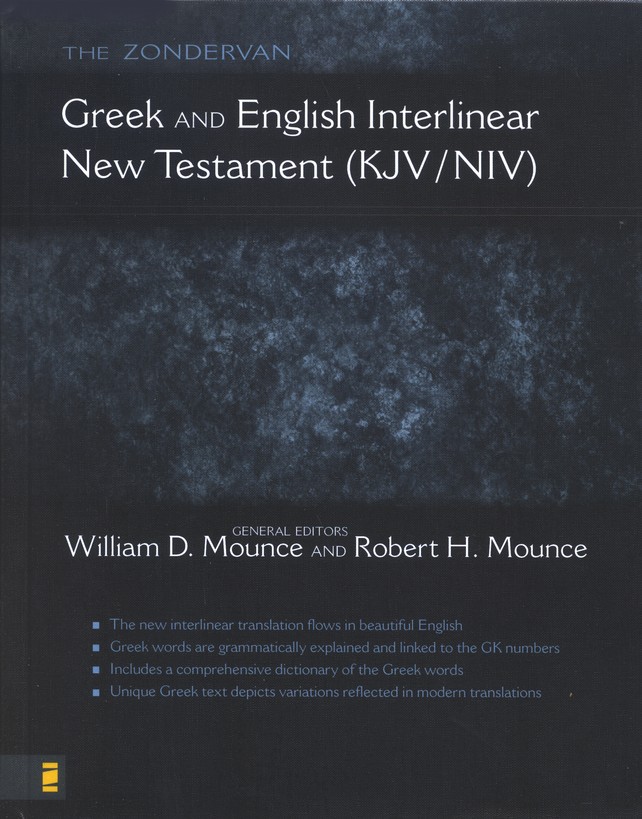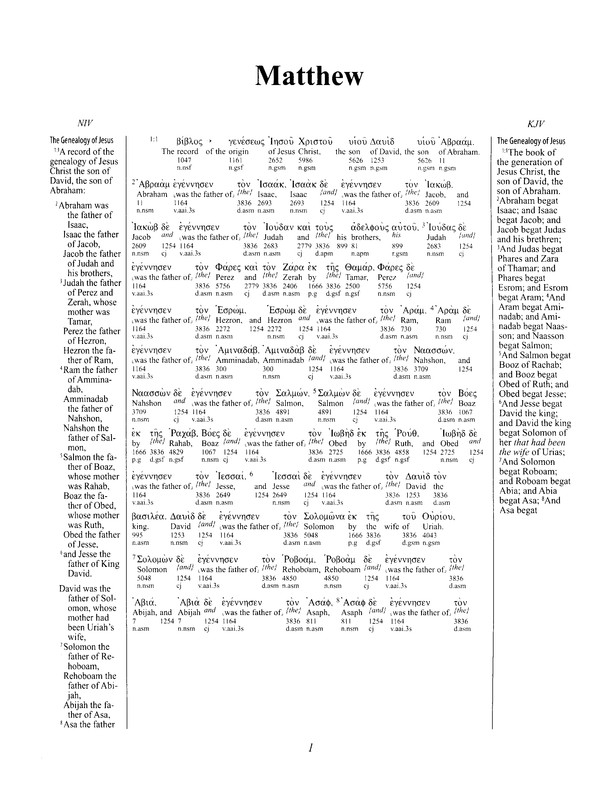-
Welcome to Baptist Board, a friendly forum to discuss the Baptist Faith in a friendly surrounding.
Your voice is missing! You will need to register to get access to all the features that our community has to offer.
We hope to see you as a part of our community soon and God Bless!
You are using an out of date browser. It may not display this or other websites correctly.
You should upgrade or use an alternative browser.
You should upgrade or use an alternative browser.
Does ANY here have A reverse Interlinear And use it?
- Thread starter JesusFan
- Start date
Like many of your questions, my answer is merely an opinion.
The reverse interlinear is a Logos product.
In most interlinears, the Greek text is the base text and the English underlies it.
A reverse interlinear uses the English text as the main text and the Greek text (from which the English is drawn) is underneath.
The advantage for non-Greek readers is that you can purchase your own preferred bible version and see how they translated a particular word or phrase.
Example: from 1 Corinthians 1:18
the word (surface)
Ὁ λόγος (manuscript)
ho logos (manuscript transliteration)
Ὁ λόγος (lemma)
ho logos (lemma transliteration)
NNSM (morphology) [noun nominative singular masculine]
3056 (Strong’s number)
33.98 (Loew-Nida number)
IMO the reverse interlinear is even a step closer to the English compared to a traditional interlinear --- not always a good thing if you want to learn to read Greek but if you know you’ll never spend the time to learn it, the product is a help.
Review a Reverse Interlinear Tutorial [LINK]
The Reverse Interlinear is available in for the English Standard Version in a book form, [LINK], it’s far cheaper but not as useful as the digitalized product.
I'd suggest reading the Amazon reviews too.
Rob
The reverse interlinear is a Logos product.
In most interlinears, the Greek text is the base text and the English underlies it.
A reverse interlinear uses the English text as the main text and the Greek text (from which the English is drawn) is underneath.
The advantage for non-Greek readers is that you can purchase your own preferred bible version and see how they translated a particular word or phrase.
Example: from 1 Corinthians 1:18
the word (surface)
Ὁ λόγος (manuscript)
ho logos (manuscript transliteration)
Ὁ λόγος (lemma)
ho logos (lemma transliteration)
NNSM (morphology) [noun nominative singular masculine]
3056 (Strong’s number)
33.98 (Loew-Nida number)
IMO the reverse interlinear is even a step closer to the English compared to a traditional interlinear --- not always a good thing if you want to learn to read Greek but if you know you’ll never spend the time to learn it, the product is a help.
Review a Reverse Interlinear Tutorial [LINK]
The Reverse Interlinear is available in for the English Standard Version in a book form, [LINK], it’s far cheaper but not as useful as the digitalized product.
I'd suggest reading the Amazon reviews too.
Rob
Last edited by a moderator:
franklinmonroe
Active Member
You have a lot of great questions, but could you slow down a bit? You can ask 'em faster than we can answer 'em. Thanks, bro.And if so, is it better then a "normal" one for bible study?
I wish there was one for the OT. I wish the paper was better in the newer ones in the NT edition. My old NT based on the NIV was given to a colleague since I had the ESV version. I miss the old one if for no other reason than the quality of the binding and pages are so much better.
Logos Bible Software provides Reverse Interlinear data for numerous versions,I wish there was one for the OT. I wish the paper was better in the newer ones in the NT edition. My old NT based on the NIV was given to a colleague since I had the ESV version. I miss the old one if for no other reason than the quality of the binding and pages are so much better.
AV, NIV84, NAS, NRSV, ESV, NLT, and probably quite a few others.
An OT version of the product would be quite bulky but it is available digitally.
Rob
I wish there was one for the OT. I wish the paper was better in the newer ones in the NT edition. My old NT based on the NIV was given to a colleague since I had the ESV version. I miss the old one if for no other reason than the quality of the binding and pages are so much better.
was there one done by believe macreynolds?
remember having that one at one time, think was in NRSV?
Logos Bible Software provides Reverse Interlinear data for numerous versions,
AV, NIV84, NAS, NRSV, ESV, NLT, and probably quite a few others.
An OT version of the product would be quite bulky but it is available digitally.
Rob
was there one produced yeras ago by Zonderbvan based on NIV by believe Kollenberger?
was there one produced yeras ago by Zonderbvan based on NIV by believe Kollenberger?
I have the Interlinear NIV Hebrew-English Old Testament in my personal library. Hebrew font is larger than most and the paper quality is nice. Includes the NIV 1984 text in a second column. Thick book, but hardcover and binding is solid.
...Bob



Last edited by a moderator:
I have the Interlinear NIV Hebrew-English Old Testament in my personal library. Hebrew font is larger than most and the paper quality is nice. Includes the NIV 1984 text in a second column. Thick book, but hardcover and binding is solid.
...Bob



thats the one!
is yours 1 volume?
Mine was a 4 Volume set!
thomas15
Well-Known Member
was there one produced yeras ago by Zonderbvan based on NIV by believe Kollenberger?
I have this book, it is titled: Interlinear for the Rest of Us: The Reverse Interlinear for New Testament Word Studies by William Mounce. The English text is the NIV with the Goodrick-Kohlenberger numbers (not Strongs numbers). There are no numbers for the greek text which is at the bottom of the page, in a little small font. There is a nice little greek pep talk in the beginning of the book. When I finally commit to learning greek, this will be the last thing I read before I begin to actually learn the language.
Personally, I only use this book for one purpose; that is to get the Goodrick-Kohlenberger numbers so that I can look up information in the New International Dictionary of New Testament Theology: Abridged Edition by Verlyn Verbrugge. There are of course other ways of finding these numbers, for example using a chart to convert from Strongs but I'm a book junkie and I found this book on the used market at a reasonable price. Also, there is a lot of greek grammar info.
The book uses thin Bible paper but measures in a large format, same size as the above mentioned dictionary.
Last edited by a moderator:
thats the one!
is yours 1 volume?
Mine was a 4 Volume set!
Mine is 1 volume. I did not know Zondervan ever published a 4-volume Interlinear NT.
...Bob
I have this book, it is titled: Interlinear for the Rest of Us: The Reverse Interlinear for New Testament Word Studies by William Mounce. The English text is the NIV with the Goodrick-Kohlenberger numbers (not Strongs numbers). There are no numbers for the greek text which is at the bottom of the page, in a little small font. There is a nice little greek pep talk in the beginning of the book. When I finally commit to learning greek, this will be the last thing I read before I begin to actually learn the language.
Personally, I only use this book for one purpose; that is to get the Goodrick-Kohlenberger numbers so that I can look up information in the New International Dictionary of New Testament Theology: Abridged Edition by Verlyn Verbrugge. There are of course other ways of finding these numbers, for example using a chart to convert from Strongs but I'm a book junkie and I found this book on the used market at a reasonable price. Also, there is a lot of greek grammar info.
The book uses thin Bible paper but measures in a large format, same size as the above mentioned dictionary.
Thanks for the information.
...Bob
I am a retired business man, not a pastor. For NT interlinear I use two.
The NRSV New Greek-English Interlinear New Testament. I have both the personal size and full size editions. Although there are no Strong's or GK numbers, I really like the large Greek font in the full size edition. I also like the textual variants identified at the bottom of the page. The side-bar translation is NRSV.


My second NT interlinear is The Zondervan Greek and English Interlinear New Testament KJV/NIV. This interlinear has more information than the first one that I listed. However, all of this additional information comes at the cost of smaller font size. GK numbers appear below the literal word-for-word translation. Some textual variants appear at the bottom of the page, but not near as many with the first interlinear. The side-bar translations are NIV 1984 and KJV.


I considered a reverse interlinear with the NIV 1984 text. However, I decided I would stay with the two regular interlinears listed above. I have used LOGOS software (and others) in the past. Now, in my retirement, I am pretty much paper format. With one exception, I use E-Sword for KJB studies.
...Bob
The NRSV New Greek-English Interlinear New Testament. I have both the personal size and full size editions. Although there are no Strong's or GK numbers, I really like the large Greek font in the full size edition. I also like the textual variants identified at the bottom of the page. The side-bar translation is NRSV.


My second NT interlinear is The Zondervan Greek and English Interlinear New Testament KJV/NIV. This interlinear has more information than the first one that I listed. However, all of this additional information comes at the cost of smaller font size. GK numbers appear below the literal word-for-word translation. Some textual variants appear at the bottom of the page, but not near as many with the first interlinear. The side-bar translations are NIV 1984 and KJV.


I considered a reverse interlinear with the NIV 1984 text. However, I decided I would stay with the two regular interlinears listed above. I have used LOGOS software (and others) in the past. Now, in my retirement, I am pretty much paper format. With one exception, I use E-Sword for KJB studies.
...Bob
Since my vocab is habitually "rusty", an interlinear for devotional and general reading is a blessing.
But why would one start with a man-made translation and try to fit the inspired God-breathed words into it??
We had a pastor friend who spent 3 years "rewriting" the Greek to coincide with the KJV (whichever edition he thought was perfect). He actually changed the Greek words, endings, plurals, etc to match the KJV.
I withstood this idolatrous attack on God's Word and we've never spoken again. The word order, syntax and grammatical structure of the inspired Words is not to be tampered with imho.
But why would one start with a man-made translation and try to fit the inspired God-breathed words into it??
We had a pastor friend who spent 3 years "rewriting" the Greek to coincide with the KJV (whichever edition he thought was perfect). He actually changed the Greek words, endings, plurals, etc to match the KJV.
I withstood this idolatrous attack on God's Word and we've never spoken again. The word order, syntax and grammatical structure of the inspired Words is not to be tampered with imho.
Yet never-the-less, we do change these every time we translate the original languages of scripture.The word order, syntax and grammatical structure of the inspired Words is not to be tampered with imho.
The reverse-interlinear is merely a simple tool to bring a novice closer to the original meaning of each English word and phrase.
Rob

